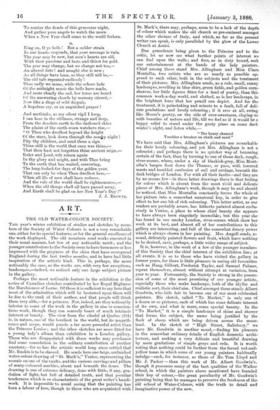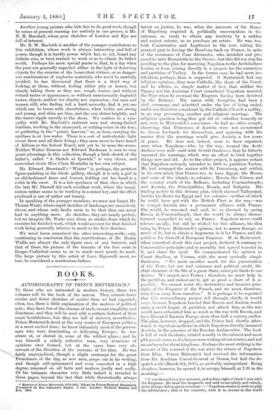ART.
THE OLD WATER-COLOUR SOCIETY.
Tim year's winter exhibition of studies and sketches by mem- bers of the Society of Water Colours is not a very remarkable one, either for its special features, or for the general excellence of the work displayed. The old members send works executed in their usual manner, but few of any noticeable merit ; and the younger contributors to the Society seem to have been more or less impressed with the greyness of the skies that have overspread England during the last twelve months, and to have had little inspiration of the artistic kind. This is, perhaps, the more noticeably the case, as the works are, with very few exceptions, landscapes,—indeed, we noticed only one large subject picture in the gallery.
Perhaps the most noticeable feature in the exhibition is the series of Canadian sketches contributed by her Royal Highness the Marchioness of Lorne. Of these it is sufficient to say here that most of the admiration which will be bestowed upon them will be due to the rank of their author, and that people will think them very able,—for a princess. Nor, indeed, are they noticeably inferior to some of the work in the gallery in aim or conscien- tious work, though they can scarcely boast of much intrinsic interest or beauty. The view from the citadel at Quebec (101) is, in nature, one' of the loveliest in the world, but its magnifi- cence and scope, would puzzle a far more powerful artist than the Princess Louise ; and the other sketches are more fitted for a young lady's album than exhibition in a London gallery. Those who are disappointed with these works may perchance find some consolation in the solitary contribution of another amateur,—for so has the artistic world long since settled that Mr. Ruskin is to be classed. He sends here one large, unfinished water-colour drawing of "St. Mark's," Venice, representing the mosaic on one of the vaults, and the various carvings and pillars of many-coloured marbles, about and beneath the dome. The drawing is one of extreme delicacy, done with little, if any, gra- dation of light, but full of detailed truth, and that peculiar tenderness which is so characteristic of the great writer's handi- work. It is impossible to avoid seeing that the painting has been a labour of love, though to those who are acquainted with St. Mark's, there may, perhaps, seem to be a lack of the depth of colour which makes the old church so pre-eminent amongst the other shrines of Italy, and which, as far as the present writer can speak, is only paralleled by the glow of the Lower Church at Assisi.
Due precedence being given to the Princess and to the critic, let us now see what further points of interest we can find upon the walls ; and first, as in duty bound, seek our entertainment at the hands of the lady painters. Chief among these stand Mrs. Allingham and Miss Clam Montalba, two artists who are as nearly as possible op- posed to each other, both in the subjects and the treatment of their pictures. Mrs. Allingham sends, as a rule, small, sunny landscapes, revelling in blue skies, green fields, and golden corn- sheaves, her little figures fitter for a land of poetry, than this common work-a-day world, and clothed, as is her landscape, in the brightest hues that her pencil can depict. And for the- treatment, it is painstaking and minute to a fault, full of deli- cate gradations and lovely colouring; if it errs at all, erring- like Moore's poetry, on the side of over-sweetness, cloying us. with beauties of nature and life, till we feel as if it would be a happy relief to stand under the gusty pines on some dark winter's night, and listen while,— " The hoary channel
Tumbles a breaker on chalk and sand."
We have said that Mrs. Allingham's pictures are remarkable for their lovely colouring, and, yet Mrs. Allingham is not a colourist ; and perhaps there is no quicker way of becoming certain of the fact, than by turning to one of those dark, rough, river-scenes, where, under a sky of blackish-grey, Miss Mont- alba's barges float down the Thames, or pass, with lowered. masts and tumbled confusion of sail and cordage, beneath the dark bridges of London. For with all their faults—and they are by no means few—in these latter drawings there is that feeling for colour which is absent from the most vivid and delicate- pieces of Mrs. Allingham's work, though it may be and should be noticed, that Miss Montalba constantly forces the whole of her picture into a somewhat unnatural key, in order to give effect to her one bit of rich colouring. This latter artist, as our readers are probably aware, has hitherto painted almost exclu- sively in Venice, a place to whose chief beauty she appears to have always been singularly insensible; but this year she has found in our smoky London, river-scones which show her work at its best, and almost all of her contributions to this gallery are interesting, and full of the somewhat dreary power which is always shown in her painting. Mrs. Angell sends, as usual, delicately painted flowers and fruit, which leave nothing. to be desired, save, perhaps, a little wider range of subject.
It is, however, in the work of a few of the younger members of this Society that the chief interest of the exhibition lies; at all events, it is so to those who have visited the gallery in former years, for there is little pleasure in seeing old favourites such as Haag, Gilbert, Frederick Tayler, and Samuel Palmer, repeat themselves, almost without attempt at variation, from year to year. Fortunately, the Society is strong in the posses- sion of some of the most promising of our younger artists,. especially those who make landscape, both of the idyllic and realistic sort, their chief aim. Chief amongst these stands Albert Goodwin, who bids fair to become one of our most celebrated painters. His sketch, called " To Market," is only one of a dozen or so pictures, each of which has some delicate interest of its own, and what is more, some special beauty. In the- "To Market." it is a simple landscape of shine and shower that forms the subject, the name being justified by the flock of sheep which are being driven across the moor- land. In the sketch of "High Street, Salisbury," we have Mr. Goodwin in another mood,—finding his pleasure in the somewhat ordinary details of English domestic archi- tecture, and making a very delicate and beautiful drawing by mere gradations of simple greys and reds. It is worth noting that nothing could be further from the forced red-and- yellow tones in which some of our young painters habitually indulge—such, for instance, as those of Mr. Tom Lloyd and Mr. J. Parker—than this work of Mr. Albert Goodwin's, though it possesses many of the best qualities of the Walker school, in which the painters above mentioned have founded their key of colour,—the great peculiarity of Mr. Goodwin's painting being that he manages to preserve the freshness of the old school of Water-Colours, with the truth to detail and imaginative power of the new. Another young painter who bids fair to do good work, though he seems at present running too entirely in one groove, is Mr. H. M. Marshall, whose grey sketches of London and Rye are full of interest.
Mr. R. W. Macbeth is another of the younger contributors to this exhibition, whose work is always interesting and full of power, though it is hardly power which has, as yet, found any definite aim, or been trained to work so as to obtain its fullest result. Perhaps his most special praise is, that, in a day when the poor are generally regarded either in the light of deserving objects for the exercise of the benevolent virtues, or as danger- ous combinations of explosive materials, who must be carefully avoided, he has discovered that there is a third way of looking at them, without feeling either pity or horror, but simply taking them as they are ; rough, coarse, and without refined tastes or appearance, as without unnecessarily degraded tastes, objects neither for charity nor repression ; but men and women still, who finding toil a hard necessity, find it yet one which can be borne with cheerfulness, when bodies are strong and young, and skies are blue, and the sun shines brightly, and the waves ripple merrily to the shore. We confess to a sym- pathy with Mr. Macbeth's stalwart men and strong-limbed maidens, working in the stoneyard, or cutting osiers in the fens, or gathering in the "potato harvest," or, as here, carrying the sardines in at low-water. There is a sort of anti-electric light about them and all their doings ; they seem never to have heard of Edison or the School Board, and yet to be none the worse. Neither Walter Duncan nor Edward Buckman is seen to very great advantage in this collection, though a little sketch of the latter's, called "A Sketch at Ipswich," is very clever, and somewhat rivals Miss Clara Montalba in her own subject.
Mr. Edward Brewtnall's " Winter " is, perhaps, the prettiest figure-painting in the whole gallery, though it is only a girl in an old-fashioned dress and bonnet, holding out her hand to a robin in the snow. It is a fair specimen of that class in which the late Mr. Pinwell did such eicellent work, where the imagi- nation rather seems to be working in a minor key, and the effect produced is one of rather sad beauty.
In speaking of the younger members, we must not forget Mr. Thorne Waite, whose rapid sketches of landscape are excessively clever, and whose only faults seem to be that they can never lead to anything more. As sketches, they are nearly perfect, but we imagine Mr. Waite uses them as studies from which he executes his finished work, which would account for that finished work being generally inferior in merit to his first sketches.
We must leave unnoticed the other interesting works, only mentioning in conclusion that the contributions of Mr. Henry Wallis are almost the only figure ones of any interest, and that of these, his picture of the tenants of the free seats in Bruges Cathedral seems to us to reach most nearly its mark. The large picture by this artist of Luca Signorelli must, we fear, be considered a meritorious failure.











































 Previous page
Previous page